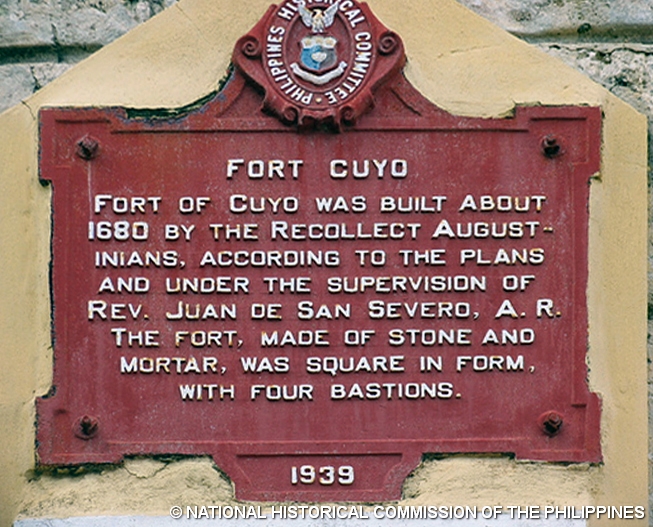Cuyo Fort on:
[Wikipedia]
[Google]
[Amazon]
Fort Cuyo is a
 In 1636, Muslim raiders looted Cuyo. To protect the locals from future raids, the Recollect Augustinians built the fort in 1680 .
Originally, Fort Cuyo was made from stone and mortar, and square-shaped with four bastions. The fort has an area of one hectare. Its wall is 10 meters high and 2 meters thick, and has a tall belfry and watchtowers.
In 1636, Muslim raiders looted Cuyo. To protect the locals from future raids, the Recollect Augustinians built the fort in 1680 .
Originally, Fort Cuyo was made from stone and mortar, and square-shaped with four bastions. The fort has an area of one hectare. Its wall is 10 meters high and 2 meters thick, and has a tall belfry and watchtowers.
citadel
A citadel is the most fortified area of a town or city. It may be a castle, fortress, or fortified center. The term is a diminutive of ''city'', meaning "little city", because it is a smaller part of the city of which it is the defensive core.
...
built in 1680 during the Spanish-era in the Philippines. It was constructed to protect the locals from Muslim invaders and other threats.
History
 In 1636, Muslim raiders looted Cuyo. To protect the locals from future raids, the Recollect Augustinians built the fort in 1680 .
Originally, Fort Cuyo was made from stone and mortar, and square-shaped with four bastions. The fort has an area of one hectare. Its wall is 10 meters high and 2 meters thick, and has a tall belfry and watchtowers.
In 1636, Muslim raiders looted Cuyo. To protect the locals from future raids, the Recollect Augustinians built the fort in 1680 .
Originally, Fort Cuyo was made from stone and mortar, and square-shaped with four bastions. The fort has an area of one hectare. Its wall is 10 meters high and 2 meters thick, and has a tall belfry and watchtowers.
Present use
Built in 1622, Saint Augustine Church, is situated inside the fort complex. It is considered as the oldest church in Palawan. In addition to the church, a convent and a chapel are within the fort's walls.Recognition
TheNational Historical Commission of the Philippines
The National Historical Commission of the Philippines (NHCP; ) is a government agency of the Philippines. Its mission is "the promotion of Philippine history and cultural heritage through research, dissemination, conservation, sites management ...
declared the fort as a historical landmark in 1939.
Notable people
In 1899, Trinidad Legarda was born inside Fort Cuyo. Her parents temporarily took refuge to escape the looting in Cuyo by bandits, led by Kausapin. In the Philippines, Legarda was the first female to become an ambassador of the country when she took office in Vietnam in 1958.References
{{ReflistSantiago
Santiago (, ; ), also known as Santiago de Chile (), is the capital and largest city of Chile and one of the largest cities in the Americas. It is located in the country's central valley and is the center of the Santiago Metropolitan Regi ...
Spanish colonial fortifications in the Philippines
National Historical Landmarks of the Philippines